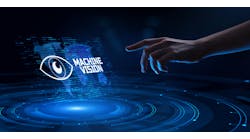When it comes to machine vision, don't oversimplify. Applications range from simple to complex, and there are many pixels in between. The gross inspections, such as presence and absence, tend to be the simple ones. Add some fine dimensional checks, contamination and defect detection, vision-guided motion or color recognition and a vision application can quickly become difficult.
Machine vision exploded in the 1980s. I vaguely recall the billions of dollars spent by venture capitalists on its development. What I clearly remember are the dozens, dare I say hundreds, of vision manufacturers at that time. I can also clearly remember the difficulty working with the custom vision systems and the custom programming needed, through personal experience as a programmer and integrator.
Fortunately the machine-vision tree of manufacturers has been greatly thinned. All players in the machine-vision segment have simplified using the vision hardware with much better programming platforms.
Expect more in the future, but it will be several years before we see new, smarter vision sensors that use artificial intelligence (AI) for much better image analysis and improved LED lighting techniques to help eliminate the glare or see through it.
There is still no one-size-fits-all solution for machine vision, although many are working in that direction. If you read or hear about autonomous machine vision that installs in minutes with no need for an integrator, that's great. But they are only telling you a short story that has been told for decades. It's a part presence sensor on steroids. That's just a narrow range of applications out there.
Considering the new machine-vision hardware and programming available, many vision applications do not require a system integrator. Being told that vision systems are difficult to support, especially by another vision-system manufacturer, is just not the case. With the smart-senor cameras and ease of programming, a machine-vision project can be done by in-house personnel and supported with little training. Some machine-vision projects most certainly will need outside resources to ensure proper implementation. It's important to know the difference.
A big part of machine-vision integration includes selection of camera, lens and lighting. The vision system must also be properly mounted and guarded to protect from vibration, unauthorized adjustments, stray light and shadows, common problems with vision systems.
Buying a complete vision system with all these required accessories, including mounting arms and brackets, in a single part number is advantageous but not required. Working closely with a vision integrator or supplier, when needed, will ensure success.
Beyond well-developed part-presence-sensing machine-vision applications, there are more difficult applications, such as measurement, position and color, that benefit from the use of experienced integrators.
It is likely these applications require careful selection of camera resolution and lens type. The illumination chosen also determines how robust and repeatable a vision system is, as does careful mounting of the camera and the position of the lighting.
I saw a video of an all-in-one machine vision solution that claims to do it all, simply, a total quality check. The solution included the camera, lens, light and mounting hardware. The video example showed excellent part-presence capability and even what appeared to be defect inspection.
It appeared the video and the camera focused on simple applications. The products had easy-to-inspect, muted surface finishes. Real-life applications have shiny or varying surface finishes. Artificial intelligence (AI) and deep learning in machine vision helps with the wide variations in surface finishes. Difficult vision applications will become easier. Take the time to check, for your application, if they already have.
The video was great marketing, but keep in mind that most if not all of the long-term players in machine vision are looking at AI. It is under development; some are using it already, but don't let AI cloud your selection process yet. AI and deep learning will greatly improve future vision systems, helping with setup, programming and set points and helping inspection algorithms.
Here is a basic fact of vision inspections—while inspections appear simple, remember there are an infinite number of ways a product can vary, which adversely affects the inspection. AI will help this, but careful selection of a lighting method minimizes reflections, just as it helps the human eye.
The AI in machine vision corrects for varying surface finishes and some improper lighting, but not all of it. Poor lighting can and will affect vision inspections. Nearby lights turning on and off may affect inspections, as well, so consider opaque guarding around the camera to make it easier for the camera algorithm and AI when or if available.
When it comes to vision, if it sounds too good to be true, be sure to understand the machine-vision system’s limits. Spend the time specifying the proper components for a particular application. There is not a single, universal solution to camera, lens, lighting and mounting thus far, no matter how intelligent the camera vendor's marketing materials or camera is.






